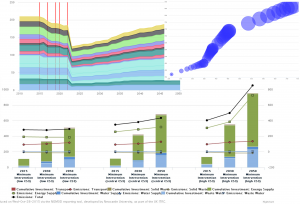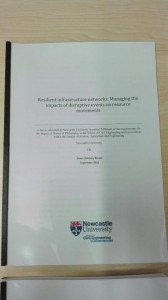Last week our latest paper was published entitled ‘Assessing urban strategies for reducing the impacts of extreme weather on infrastructure networks’ in the Royal Socities Open Science journal. Alistair Ford, Craig Robson and Stuart Barr all contributed to the artical alongside colleagues from civil engineering, Maria Pregnolato (lead authour), Vassilis Glenis and Richard Dawson. A summary is given below.
“A framework for assessing the disruption from flood events to transport systems is presented that couples a high-resolution urban flood model with transport modelling and network analytics to assess the impacts of extreme rainfall events, and to quantify the resilience value of different adaptation options. A case study in Newcastle upon Tyne in the UK is presented and shows that both green roof infrastructure and traditional engineering interventions such as culverts or flood walls can reduce transport disruption from flooding.The magnitude of these benefits depends on the flood event and adaptation strategy, but for the scenarios considered here 3–22% improvements in city-wide travel times are achieved.
Both options should form part of an urban flood risk management strategy, but this method can be used to optimize investment and target limited resources at critical locations, enabling green infrastructure strategies to be gradually implemented over the longer term to provide city-wide benefits. This framework provides a means of prioritizing limited financial resources to improve resilience. By capturing the value to the transport network from flood management interventions, it is possible to create new business models that provide benefits to, and enhance the resilience of, both transport and flood risk management infrastructures.”




